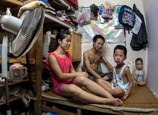
BEIJING, July 15 (Xinhua) -- China's urban fixed-asset investment grew 20.1 percent year on year to 18.13 trillion yuan (2.94 trillion U.S. dollars) in the first half of 2013, the National Bureau of Statistics (NBS) announced on Monday.
The growth rate moderated by 0.8 percentage points compared to that in the first quarter, and was down 0.3 percentage points from the same period last year, the NBS data showed.
During the first half, investment in primary industry amounted to 388.4 billion yuan, up 33.5 percent; that in secondary industry totaled 7.8 trillion yuan, up 15.6 percent; investment in tertiary industry rose 23.5 percent to hit 9.94 trillion yuan.
Investment in China's central regions grew the fastest -- by 23.6 percent, followed by 22.7 percent in the west, and 18.7 percent in the east.
Infrastructure (excluding production and supply facilities for electricity, gas, and water) investment rose 25.3 percent to 2.73 trillion yuan in the first half, according to the data.
And investment in the nation's property sector totaled 3.68 trillion yuan, up 20.3 percent year on year. Investment growth during the period rose 3.7 percentage points year on year, up 0.1 percentage point from the first quarter.
NBS figures released on Monday also showed China's gross domestic product growth slowed to 7.6 percent in the first half, down from 7.7 percent in the first quarter.
Experts attributed the deceleration of fixed-asset investment to sluggish exports, a liquidity crunch, and the transformation and upgrading of Chinese enterprises.
"Investment-driven growth can no longer be translated into the sustainable development of the Chinese economy. Instead, consumption-led economic restructuring is the government's priority," said Ma Yao, a macro-economy researcher with China Investment Consulting Corp.
Chinese Premier Li Keqiang said last week that China is in a phase in which it must rely on economic transformation and upgrading to maintain continuous and healthy development.
He said China must quicken its reform in the areas of administration, taxation, finance and pricing with the aim to let the market mechanism play a better role, make private investment more active and the market more vigorous.
More support will be channeled to the central and western part of the country, especially poverty-stricken areas, Li said, adding that the more affluent eastern part of China should strive for development at a higher level through economic transformation and upgrading.
More on China’s economic data:
? China's Q2 GDP slows to 7.5 pct
? China's H1 industrial output up 9.3 pct
? China's H1 retail sales accelerate to 12.7 pct
















 Migrant workes' high incomes not that rosy
Migrant workes' high incomes not that rosy


![]()
